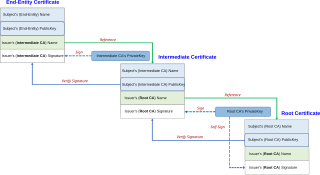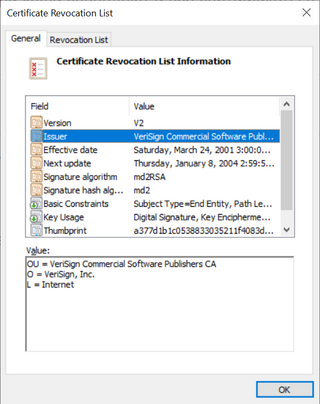
Hypertext Transfer Protocol Secure (HTTPS) is an extension of the Hypertext Transfer Protocol (HTTP). It uses encryption for secure communication over a computer network, and is widely used on the Internet. In HTTPS, the communication protocol is encrypted using Transport Layer Security (TLS) or, formerly, Secure Sockets Layer (SSL). The protocol is therefore also referred to as HTTP over TLS, or HTTP over SSL.
Transport Layer Security (TLS) is a cryptographic protocol designed to provide communications security over a computer network. The protocol is widely used in applications such as email, instant messaging, and voice over IP, but its use in securing HTTPS remains the most publicly visible.

A public key infrastructure (PKI) is a set of roles, policies, hardware, software and procedures needed to create, manage, distribute, use, store and revoke digital certificates and manage public-key encryption. The purpose of a PKI is to facilitate the secure electronic transfer of information for a range of network activities such as e-commerce, internet banking and confidential email. It is required for activities where simple passwords are an inadequate authentication method and more rigorous proof is required to confirm the identity of the parties involved in the communication and to validate the information being transferred.
In cryptography, a public key certificate, also known as a digital certificate or identity certificate, is an electronic document used to prove the validity of a public key. The certificate includes the public key and information about it, information about the identity of its owner, and the digital signature of an entity that has verified the certificate's contents. If the device examining the certificate trusts the issuer and finds the signature to be a valid signature of that issuer, then it can use the included public key to communicate securely with the certificate's subject. In email encryption, code signing, and e-signature systems, a certificate's subject is typically a person or organization. However, in Transport Layer Security (TLS) a certificate's subject is typically a computer or other device, though TLS certificates may identify organizations or individuals in addition to their core role in identifying devices. TLS, sometimes called by its older name Secure Sockets Layer (SSL), is notable for being a part of HTTPS, a protocol for securely browsing the web.
In cryptography, X.509 is an International Telecommunication Union (ITU) standard defining the format of public key certificates. X.509 certificates are used in many Internet protocols, including TLS/SSL, which is the basis for HTTPS, the secure protocol for browsing the web. They are also used in offline applications, like electronic signatures.

In cryptography and computer security, a root certificate is a public key certificate that identifies a root certificate authority (CA). Root certificates are self-signed and form the basis of an X.509-based public key infrastructure (PKI). Either it has matched Authority Key Identifier with Subject Key Identifier, in some cases there is no Authority Key identifier, then Issuer string should match with Subject string. For instance, the PKIs supporting HTTPS for secure web browsing and electronic signature schemes depend on a set of root certificates.

In cryptography, a certificate revocation list (CRL) is "a list of digital certificates that have been revoked by the issuing certificate authority (CA) before their scheduled expiration date and should no longer be trusted". CRLs are no longer required by the CA/Browser forum, as alternate certificate revocation technologies are increasingly used instead. Nevertheless, CRLs are still widely used by the CAs.
In cryptography, a certificate authority or certification authority (CA) is an entity that stores, signs, and issues digital certificates. A digital certificate certifies the ownership of a public key by the named subject of the certificate. This allows others to rely upon signatures or on assertions made about the private key that corresponds to the certified public key. A CA acts as a trusted third party—trusted both by the subject (owner) of the certificate and by the party relying upon the certificate. The format of these certificates is specified by the X.509 or EMV standard.
In cryptography and computer security, self-signed certificates are public key certificates that are not issued by a certificate authority (CA). These self-signed certificates are easy to make and do not cost money. However, they do not provide any trust value.
The certification path validation algorithm is the algorithm which verifies that a given certificate path is valid under a given public key infrastructure (PKI). A path starts with the Subject certificate and proceeds through a number of intermediate certificates up to a trusted root certificate, typically issued by a trusted certificate authority (CA).

Network Security Services (NSS) is a collection of cryptographic computer libraries designed to support cross-platform development of security-enabled client and server applications with optional support for hardware TLS/SSL acceleration on the server side and hardware smart cards on the client side. NSS provides a complete open-source implementation of cryptographic libraries supporting Transport Layer Security (TLS) / Secure Sockets Layer (SSL) and S/MIME. NSS releases prior to version 3.14 are tri-licensed under the Mozilla Public License 1.1, the GNU General Public License, and the GNU Lesser General Public License. Since release 3.14, NSS releases are licensed under GPL-compatible Mozilla Public License 2.0.
The Server-based Certificate Validation Protocol (SCVP) is an Internet protocol for determining the path between an X.509 digital certificate and a trusted root and the validation of that path according to a particular validation policy.

An Extended Validation Certificate (EV) is a certificate conforming to X.509 that proves the legal entity of the owner and is signed by a certificate authority key that can issue EV certificates. EV certificates can be used in the same manner as any other X.509 certificates, including securing web communications with HTTPS and signing software and documents. Unlike domain-validated certificates and organization-validation certificates, EV certificates can be issued only by a subset of certificate authorities (CAs) and require verification of the requesting entity's legal identity before certificate issuance.
The Online Certificate Status Protocol (OCSP) stapling, formally known as the TLS Certificate Status Request extension, is a standard for checking the revocation status of X.509 digital certificates. It allows the presenter of a certificate to bear the resource cost involved in providing Online Certificate Status Protocol (OCSP) responses by appending ("stapling") a time-stamped OCSP response signed by the CA to the initial TLS handshake, eliminating the need for clients to contact the CA, with the aim of improving both security and performance.
Server Name Indication (SNI) is an extension to the Transport Layer Security (TLS) computer networking protocol by which a client indicates which hostname it is attempting to connect to at the start of the handshaking process. The extension allows a server to present one of multiple possible certificates on the same IP address and TCP port number and hence allows multiple secure (HTTPS) websites to be served by the same IP address without requiring all those sites to use the same certificate. It is the conceptual equivalent to HTTP/1.1 name-based virtual hosting, but for HTTPS. This also allows a proxy to forward client traffic to the right server during TLS/SSL handshake. The desired hostname is not encrypted in the original SNI extension, so an eavesdropper can see which site is being requested. The SNI extension was specified in 2003 in RFC 3546
An offline root certificate authority is a certificate authority which has been isolated from network access, and is often kept in a powered-down state.
DNS-based Authentication of Named Entities (DANE) is an Internet security protocol to allow X.509 digital certificates, commonly used for Transport Layer Security (TLS), to be bound to domain names using Domain Name System Security Extensions (DNSSEC).
Let's Encrypt is a non-profit certificate authority run by Internet Security Research Group (ISRG) that provides X.509 certificates for Transport Layer Security (TLS) encryption at no charge. It is the world's largest certificate authority, used by more than 300 million websites, with the goal of all websites being secure and using HTTPS. The Internet Security Research Group (ISRG), the provider of the service, is a public benefit organization. Major sponsors include the Electronic Frontier Foundation (EFF), the Mozilla Foundation, OVH, Cisco Systems, Facebook, Google Chrome, Internet Society, AWS, NGINX, and Bill and Melinda Gates Foundation. Other partners include the certificate authority IdenTrust, the University of Michigan (U-M), and the Linux Foundation.
In public key infrastructure, a validation authority (VA) is an entity that provides a service used to verify the validity or revocation status of a digital certificate per the mechanisms described in the X.509 standard and RFC 5280.
In public key cryptography, a certificate may be revoked before it expires, which signals that it is no longer valid. Without revocation, an attacker could exploit such a compromised or misissued certificate until expiry. Hence, revocation is an important part of a public key infrastructure. Revocation is performed by the issuing certificate authority, which produces a cryptographically authenticated statement of revocation.






